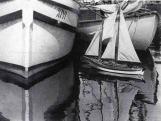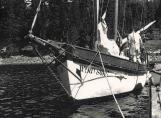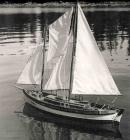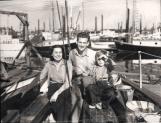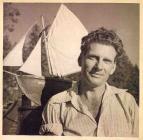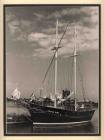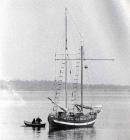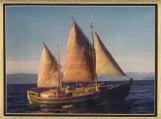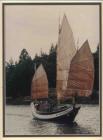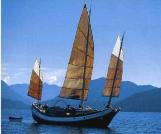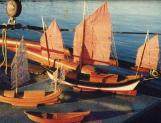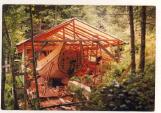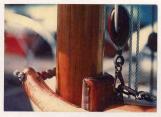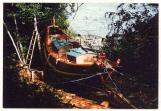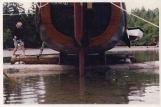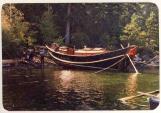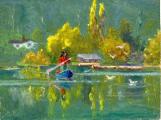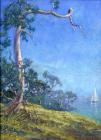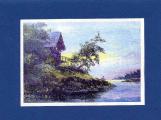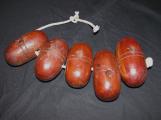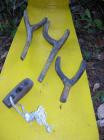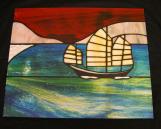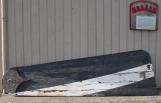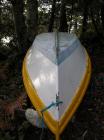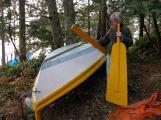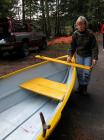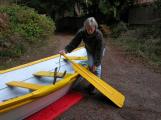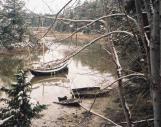

Sunshine Coast Museum & Archives
Gibsons, British Columbia
1
Farrell StoryAllen Farrell spent 69 years building over 40 wooden boats on the coast of British Columbia, Canada. Allen and Sharie Farrell would spend approximately 50 years living aboard many of their handmade vessels.
Allen's approach to boat construction was based on the methods traditionally used to build wooden workboats on the west coast of Canada. His boat designs included lapstrake (overlapping planks) and caulked (or corked) strip-planked hulls for larger vessels.
Planks were fastened to a framework of ribs attached to a keelson and were shaped from sturdy fir timbers with stem and stern pieces attached. The rough shaping was done with his favorite tool, an axe. The fine work was completed with chisels, a block plane and sandpaper. Fir, red and yellow cedar and yew were the principal woods used. Allen preferred to work from halfmodels, after testing the design and sail plan with scale models built to sail.
Some of Allen's design elements incorporated a square sail for running trade winds, an extreme sheer that gives the Farrell hulls a 'smile on the sea' trademark, and the use of leeboards as stabilizers and a shallow draught (area of the boat that is under water), as a means for inhabiting the shallow waters of our coastal inlets. The Farrells would complete six major voyages form 1951 to 1979. Destinations included Fiji, Santa Barbara, Mexico, Namu and Hawaii.
This story features images and artifacts that depict an overview of Allen and Sharie's boats and voyages, building and launching their Chinese Junk called the China Cloud, some fine handcrafted items from their boats, some of Allen's paintings, and our museum's acquisition of the final boat built by Allen Farrell.
3
'KIVI' was a 21 ft. cod boat that was built by Allen Farrell and launched in 1940. This was Allen's 2nd fishboat and it had an Easthope engine. Gumwood was used for the stem, cap and guard.Kivi is now mounted for display inside a restaurant in downtown Vancouver, B.C.
Also in the centre of this photo, taken in 1953, is the model for Allen's next boat, WindSong; and in the rear, to the right in the photo is a boat called Balandra, which was built by Colin Hanney, photographer and friend of Allen and Sharie.
5
WindSong was the first boat that was built and launched by Allen and Sharie Farrell together in 1949 in Bargain Harbour, Pender Harbour area of the Sunshine Coast.WindSong was a 36 ft schooner that they sailed to Hawaii and then to Fiji in 1951-52. After 56 days at sea, they arrived in Suva Harvour, Fiji and sold the boat. Four days later, WindSong sank in the harbour during the worst hurricane of the year.
7
Allen Farrell would build models and test his designs before building the full sized boat from a halfmodel. In this photo, Allen is testing the model for WindSong.Keray Farrell, Allen's son, said that his father usually took 2 years to build his boats.
9
WindSong on the Ways, circa 1950WindSong was launched in 1947 in Bargain Harbour and was Allen and Sharie's first 36 ft. cruising vessel.
Photographer and friend, Colin Hanney took this photo while Allen had the boat on the ways in Bargain Harbour doing some bottom work. The image in the background is Allen.
11
This photo of Allen, Sharie and Keray Farrell was taken in 1951 in Coal Harbour, Vancouver, British Columbia.They are preparing to set sail to Hawaii. Some of the going-away gifts to the family included canned goods, a sextant, and the book 'How to Steer by the Stars.' Allen would learn how to take sun and star sightings.
Keray was about 8 years old at the time of this voyage, and has now reflected that 56 days out on a very rough sea has probably cured him of sailing.
13
This is a photo of Allen Farrell in front of his model of Ocean Bird, which would be a 30 ft. cutter design that Allen launched in 1958. Allen and Sharie were homesteading on Nelson Island, Pender Harbour area at the time.Ocean Bird was made with red cedar planks on 1" yelow cedar frames. This boat took 4 years to build.
According to Keray Ferrall, Ocean Bird is in the Lund area of the Sunshine Coast being restored.
15
The 'Ocean Girl' was a 45 ft. Barkentine schooner that was launched in 1960 in Bargain Harbour. This was the most comfortable of the larger Farrell vessels with a spacious galley and a 5 ton cargo hold.'Ocean Girl' was built in 2 1/2 yrs and carried 7 sails, including a square sail set from the foremast. 'Ocean Girl' was sailed to Santa Barbara in 1960 and to Mexico and Hawaii in 1961-62.
In this photo, the Farrells are docked. Note the laundry hanging on the mast.
17
'Native Girl' was a 39 ft. ketch that was launched in 1965 on Nelson Island, Pender Harbour area of the Sunshine Coast.'Native Girl' was a sleek, seaworthy double-ender with a smooth cutaway forward and a deep keel aft. Her curving deckline made her safe at sea. The boat has been refitted and restored in 1995 by the current owner.
Allen and Sharie Farrell sailed 'Native Girl' to Namu in 1965, to Hawaii in 1968-69, and to Hawaii again in 1978-79. Allen took less than his usual 2 yrs to build this boat, and it was the only boat that he bought back.
19
The 27 ft. 'August Moon' was launched in 1973 on Lasqueti Island, British Columbia. Allen and Sharie built it as a dory with 1/2 inch plywood. Allen rigged it as a ketch with oars and no motor.Allen and Sharie only sailed and lived aboard 'August Moon' for a couple of months before buying back 'Native Girl'. A later owner has changed it to a schooner and added a deisel motor.
21
The 50 ft. 'China Cloud' was a Junk Rig that was launched in 1982, Lasqueti Island. This boat has two large bilge keels to provide lateral stability. The person at the stern has a clear view ahead.Allen and Sharie enjoyed living aboard 'China Cloud' for 14 years with no engine, no refrigeration, no radar, and no VHF radio.
The new white dacron sails were dyed to an umber color. The big, fully battened sails would move 'China Cloud' at two knots with even the slightest breeze.
23
The extreme sheer and upward swing of the stern of 'China Cloud' are the typical "smile of the sea" designs that characterized the Farrell boats.'China Cloud' had a low cabin, a skylight and 2 solar panels. The sails lie across the mast, so sheeting them in doesn't take much energy.
Allen created a system that had just one pair of sheets for controlling each sail. This meant that one person at the helm could control all of the sails with just one line.
This is an early photo of 'China Cloud'; for the first two years, Allen used sails made out of the tarp under which the boat was made, before ordering new ones.
25
This is a photo of 3 junk models that were built by Allen Farrell to test his designs for a new boat. He needed to be sure that junk sails would really work, so he built a series of models and sailed them in all sorts of wind conditions.27
Allen Farrell's 'China Cloud' was built with only simple handtools; an axe, saw, plane, and chisel.Allen worked under a large tarpulin - covered shed while living aboard 'Native Girl'. The orange tarp was used for sails for 2 years before replacing with dacron ones.
Allen's son Keray, relayed that the fellow that helped Allen mill the lumber for 'China Cloud' was later involved in a serious accident that was not related to Allen's project.
29
Allen and Sharie Farrell completed the details of their new boat 'China Cloud', beginning with the keel, ribs and deck beams, and ending with the planking, decks, cabins and interior. Allen did the rough shaping with an axe and finished with a saw, a plane and a chisel.31
This is a photo of a close up of the fir stave that supports the mainsail. It is an indication of Allen's artistic ability and wonderful use of color that he also displayed in his paintings.Allen's son, Keray described this photo as the boom vange on the main sail & halyard to pull in the sails on 'China Cloud'.
33
Allen and Sharie Farrell would live aboard 'China Cloud' for 14 years. Allen was convinced that a Junk Rig is ideal for the coastal waters of British Columbia.35
Allen wanted the new 'China Cloud' ready to live aboard when Sharie returned from a stay in a hospital, so he launched her almost single handedly using block and tackle. He maneuvered the big boat around trees and rocks, then gradually lowered it down a steep slope.37
The rudder of 'China Cloud' is balanced and it pulls up so when it sits on the mud, Allen could climb down and work on the bottom anywhere, without having to pay someone to haul it out.In this photo, 'China Cloud' is sitting in False Bay, Lasqueti Island, British Columbia.
39
'China Cloud' draws only 2 1/2 ft., has no ballast, but she sails well and is so stable. Allen could come-about within a few feet of a rocky shore and navigate between closely anchored boats with confidence.In this photo, Allen's son Keray said that 'China Cloud' was getting her "first taste of water". She was the easiest boat to launch, after August Moon.
41
Allen Farrell painted for more than 50 years, using oils. He captured the beauty and play of light on water and the subtlety of color in the sky.Sharie was also a remarkable painter. However, most of the paint she used over the years was applied to the hulls and cabins of the numerous vessels which they built and maintained.
This painting was donated to our museum from Allen and Sharie's life-long friend, Shendra Hanney.
43
This painting of Allen Farrell's is signed and dated 1995. Allen loved the arbutus tree and it is featured here and in many other of his scenes.45
This is one of Allen Farrell's paintings that he himself sent to friends, Colin and Shendra Hanney for a Christmas card. There is a personal note inside. This is only one of many that he mailed out to friends over the years.Shendra Hanney donated this card to our Museum for the Farrell Collection.
47
These are handcarved pulleys that Allen made for the 'China Cloud' to control the sails. These are proudly on display at the Sunshine Coast Museum and Archives as part of the Farrell Collection.49
This large pulley carved by Allen Farrell for 'China Cloud' was made from yew wood, which is very hard wood. It is used for pulling up the anchor.51
Handcarved oarlocks & pulley made by Allen Farrell for his last boat, a skiff called 'Peace & Quiet' and later renamed 'Buttercup' by Corlynn Hanney when Allen gave her the boat. The oarlocks and pulley are made from arbutus wood, an extremely hard wood. The natural reddish color of the wood has been transformed due to numerous applications of tung oil rubbed in as a preservative.53
This beautiful stain glass image is of 'China Cloud', Allen Farrell's last major vessel. This beautiful artwork was created for one of Allen's nieces and is part of the Farrell Collection at the Sunshine Coast Museum and Archives.55
This is the original leeboard from 'China Cloud' that is part of the Farrell Collection at our museum. It was taken outside for a full view, since the leeboard measures 10 ft. long by 3.5 ft. wide.57
The last Farrell boat was the 18 ft. 'Peace and Quiet' that they sailed and rowed back to Nelson Island after Sharie's lengthy hospital stays. All the wood was beachcombed from the beaches in West Vancouver.After Sharie died, Allen gave the boat to a dear friend and Colin Hanney's daughter, Corlynn Hanney. Corlynn repainted and renamed the boat to 'Buttercup'.
'Buttercup' was recently donated to our museum to join with the other items in the Farrell Collection.
59
Corlynn Hanney examines, with affection, the rudder that belongs to 'Buttercup'. In the background of the photo is a faint view of Bargain Harbour, where Allen and Sharie built 'Native Girl'.61
In this photo, Corlynn is demonstrating the position of the crossbar for the yuloh, the propelling mechanism or Chinese sculling oar used with 'Buttercup'.63
In this photo, Corlynn Hanney is demonstrating how the rudder is positioned and easily switched to the other side of the boat according to the direction of the wind, and/or currents.65
In this photo taken by Tom Lavis, the 'China Cloud' is viewed at anchor at Lasqueti Island.After Sharie died, Allen returned to Lasqueti to live aboard their beloved 'China Cloud'. This photo was taken 1 week before Allen died.
66
ConclusionDuring decades of homesteading on the British Columbia Coast, building wooden boats and sailing up and down North America and across the Pacific, the Farrells have earned a living at times by fishing, digging clams, giving hair cuts and beachcombing. They considered that life on the sea and sustaining themselves with the local food resources was indeed a blessing that they in turn shared with all those that encountered them.
Many of the images and text for this Farrell story are part of the travelling exhibit called 'Salt on the Wind'. This photographic exhibit can be booked by contacting the Sunshine Coast Museum.
